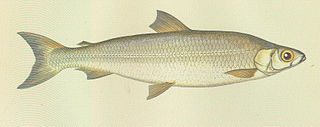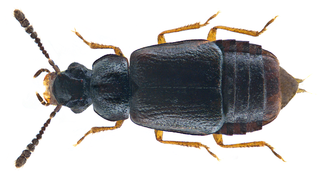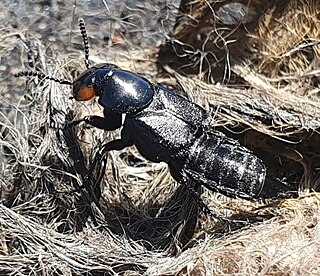
The rove beetles are a family (Staphylinidae) of beetles, primarily distinguished by their short elytra that typically leave more than half of their abdominal segments exposed. With over 66,000 species in thousands of genera, the group is the largest family in the beetle order, and one of the largest families of organisms. It is an ancient group, with fossilized rove beetles known from the Triassic, 200 million years ago, and possibly even earlier if the genus Leehermania proves to be a member of this family. They are an ecologically and morphologically diverse group of beetles, and commonly encountered in terrestrial ecosystems.

The pollan or Irish pollan is a freshwater whitefish known only from five Irish lakes, Lough Neagh, Lower Lough Erne, Lough Ree, Lough Derg and Lough Allen. The pollan faces competition from introduced species such as pike, roach and zebra mussel, and the populations rely on restocking for survival.

Creophilus maxillosus, the hairy rove beetle, is a species of rove beetle.

Stenus is a genus of semiaquatic rove beetles in the subfamily Steninae, and one of the largest genera in the kingdom Animalia, with some 3100 known species worldwide. They are predators of Collembola and other small arthropods. Adults have a protrusible labium with a sticky tip used in prey capture. To overcome the rapid escape of Collembola, the labium is protruded at high speed by hemolymph pressure, and immediately withdrawn, pulling the prey within the range of the mandibles. However, the labium tip does not easily stick to prey covered in scales or setae or that have a large body size. Stenus comma is more likely to catch such prey by lunging forward and grabbing them directly with its mandibles rather than using its labium. Stenus species are also known for "skimming" on the water surface using their pygidial gland secretions that act as a surfactant and rapidly propel the beetle fast forward, a phenomenon known as the Marangoni effect. Stenus comma has been seen to achieve a velocity of 0.75 m/s, and to cover a distance of up to 15 m if the secretion is continuous.

The pictured rove beetle is a wingless rove beetle which lives on the sandy beaches of the West Coast of the United States from southern Alaska to Baja California. It is nocturnal, emerging at night from temporary sand burrows to feed on beach hoppers (Orchestoidea).
Anthony Adrian Allen was a British entomologist who published several hundred scientific papers, in particular on the Coleoptera (beetles) of the British Isles. He was active for much of the middle and late 20th century. He formed a bridge between the great entomologists of last century, and the present generation, many of whom benefitted from his knowledge and guidance.

The Paederinae are a subfamily of the Staphylinidae, rove beetles. As of 2024, three tribes are accepted within this subfamily: Lathrobiini, Paederini, and Pinophilini. This insect is commonly known as Tomcat.
Oxford Island is a National Nature Reserve and public recreation site on the southern shores of Lough Neagh at Lurgan, County Armagh. The site covers 282 acres and is owned and maintained by Armagh City, Banbridge and Craigavon Borough Council. Much of the area is designated as a National Nature Reserve due to its wide variety of natural habitats. The purpose of all work on the island is to maintain biodiversity and to provide a recreation area for everyone.

The Aleocharinae are one of the largest subfamilies of rove beetles, containing over 12,000 species. Previously subject to large-scale debate whether the subfamily deserved the familial status, it is now considered one of the largest subfamilies of rove beetles.
Bledius annularis, or ringed borrow rove beetle, is a species of spiny-legged rove beetle in the family Staphylinidae. It is found in North America.

Omaliini is a tribe of ocellate rove beetles in the family Staphylinidae. There are about 45 genera and 450 described species in Omaliini.

Rugilus rufipes is a species of rove beetle in the family Staphylinidae. It is commonly found across Europe and parts of North America. These beetles are known for their slender bodies and distinctive red legs, which give the species its name.
Oxytelus nigriceps is a species of rove beetle widely spread in Asia. It is found in China, Hong Kong, South Korea, Japan, Philippines, Vietnam, Thailand, Myanmar, Malaysia, Singapore, Indonesia, New Guinea, Bismarck Islands, Pakistan, India, Nepal, Sri Lanka, and Bangladesh.
Oxytelus puncticeps is a species of rove beetle widely spread in Asia and Africa. It is found in China, Hong Kong, Taiwan, Japan, Philippines, Vietnam, Indonesia, Borneo, Sri Lanka, India, and Sub-Saharan Africa.

Stenus melanarius is a species of rove beetle widely spread in Asia and Europe. It is a natural predator of the pest, Cnaphalocrocis medinalis.
Stenus solutus is a species of rove beetle widely spread in Asia and England.

Creophilus oculatus or devil's coach horse is a species of large carrion-feeding rove beetle endemic to New Zealand.
Dr Derek Arthur Lott F.E.S. was a British entomologist and museum curator, known for his studies of Coleoptera and biodiversity recording.
Peter Michael Hammond was a British entomologist who specialised in Coleoptera (beetles). For many years he was the head of the Coleoptera section at the Natural History Museum, London.










